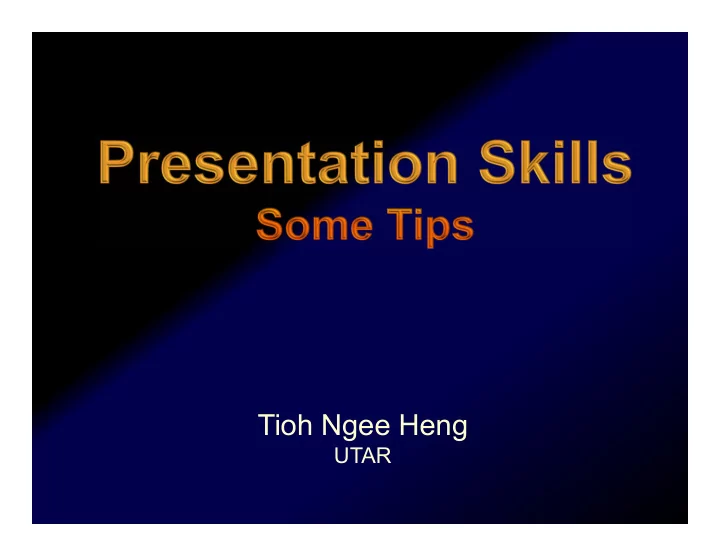

Tioh Ngee Heng UTAR
Objectives for Today By the end of the session, participants will be able to… utilize eye contact, body language and voice to their advantage in a presentation, apply the 3 A’s in preparing content for a presentation, develope visual aids that reflect good instructional design properties, and respond to questions in an effective manner.
General Competencies Interpersonal Communication Professionalism Practice-Based Learning & Improvement
Podium Panic For some people, the thought of giving a presentation is frightening…...
Dealing with Podium Panic Audiences are forgiving Nervousness is usually invisible Be yourself Practice deep breathing/ visualization techniques Begin in your comfort zone
Check out the room in advance Concentrate on the message Begin with a slow, well prepared intro; have a confident and clear conclusion Be prepared and practice
Eye Contact Never let them out of your sight. Looking them in the eye makes them feel that they are influencing what you say. Eye contact allows the presentation to approximate conversation—the audience feels much more involved.
Body Language NO-NO’s Lean on or grip the podium Rock or sway in place Stand immobile Use a single gesture repeatedly Examine or bite your fingernails
Body Language NO-NO’s Cross your arms in front of your chest Use obviously practised or stilted gestures Chew gum or eat candy Click or tap your pen, pencil or pointer
Body Language NO-NO’s Lean into the microphone Shuffle your notes unnecessarily Tighten your tie or otherwise play with your clothing Crack your knuckles Jangle change or key in your pocket
Voice Voice Variability Voice Intelligibility Rate of speech Articulation Pronunciation Volume Vocalized Pitch or tone pauses Emphasis Overuse of stock expressions Substandard grammar
Preparing Content 3 A’s Analyze your AUDIENCE . Define what ACTION you want them to take. Arrange your ARGUMENT to move them.
Analyze Your Audience What are their names, titles, backgrounds, reasons for attending, etc…? What are their big concerns? What are their objectives, fears, hot buttons, and attitudes?
Analyze Your Audience What is their perception of you and your institution? What are their questions likely to be? What is personally at stake for them? How much detail do they need?
Define What Action What action do you want the audience to take? Define it in terms of the audience. What will they feel, believe, and do after hearing your talk?
Arranging Your Argument 1. Shake hands with the audience. 2. Get to the point. 3. Present your theme. 4. Develop your agenda point by point. 5. Summarize and recommend.
Visual Aids
Visual Aids (not the stars of the show)
Design Concepts •Big •Simple •Clear
Big •Should be able to read everything from the back row •At least 28 pt, preferably 36 •Use the floor test
Simple •No more than 6 lines •No more than 7 words per line
Clear •Arial or Helvetica •Dark background with yellow text •Avoid overuse of red, shadows, animation and transitions •Beware of busy backgrounds
Clear •Clip art should add to the content •Use a different background only to emphasize one slide
Questions & Answers “Does anyone have any questions for my answers?” -Henry Kissinger
Questions & Answers Beginning of a whole new interactive presentation Opportunity to make a point Most presentations are won or lost here
Questions & Answers Anticipate lines of Don’t repeat negative questioning questions Rehearse Clarify question Don’t rank questions Defer to experts Keep answers brief Move your eyes off questioner Be honest—don’t BS If negative, end your Avoid negative words response focused on somebody else
THE RULE NEVER argue with a member of the audience.
Instead… Look at the questioner. Remain neutral and attentive. Listen to the whole question. Pause before you respond. Address the questioner, then move your eyes to others.
Easy as A B C “I can’t A nswer that question B ecause …, but I C an tell you…”
“Better to keep your mouth shut and appear ignorant than open it and remove all doubt.” -Mark Twain
Recommend
More recommend